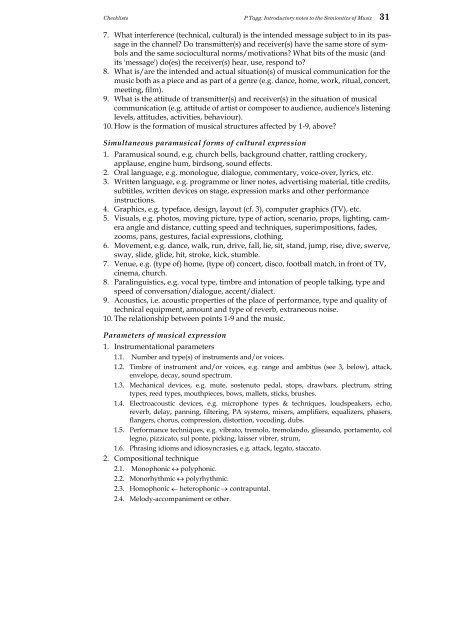Introductory notes to the Semiotics of Music - Philip Tagg's home page
Introductory notes to the Semiotics of Music - Philip Tagg's home page
Introductory notes to the Semiotics of Music - Philip Tagg's home page
Create successful ePaper yourself
Turn your PDF publications into a flip-book with our unique Google optimized e-Paper software.
Checklists P Tagg: <strong>Introduc<strong>to</strong>ry</strong> <strong>notes</strong> <strong>to</strong> <strong>the</strong> Semiontics <strong>of</strong> <strong>Music</strong> 31<br />
7. What interference (technical, cultural) is <strong>the</strong> intended message subject <strong>to</strong> in its passage<br />
in <strong>the</strong> channel? Do transmitter(s) and receiver(s) have <strong>the</strong> same s<strong>to</strong>re <strong>of</strong> symbols<br />
and <strong>the</strong> same sociocultural norms/motivations? What bits <strong>of</strong> <strong>the</strong> music (and<br />
its 'message') do(es) <strong>the</strong> receiver(s) hear, use, respond <strong>to</strong>?<br />
8. What is/are <strong>the</strong> intended and actual situation(s) <strong>of</strong> musical communication for <strong>the</strong><br />
music both as a piece and as part <strong>of</strong> a genre (e.g. dance, <strong>home</strong>, work, ritual, concert,<br />
meeting, film).<br />
9. What is <strong>the</strong> attitude <strong>of</strong> transmitter(s) and receiver(s) in <strong>the</strong> situation <strong>of</strong> musical<br />
communication (e.g. attitude <strong>of</strong> artist or composer <strong>to</strong> audience, audience's listening<br />
levels, attitudes, activities, behaviour).<br />
10. How is <strong>the</strong> formation <strong>of</strong> musical structures affected by 1-9, above?<br />
Simultaneous paramusical forms <strong>of</strong> cultural expression<br />
1. Paramusical sound, e.g. church bells, background chatter, rattling crockery,<br />
applause, engine hum, birdsong, sound effects.<br />
2. Oral language, e.g. monologue, dialogue, commentary, voice-over, lyrics, etc.<br />
3. Written language, e.g. programme or liner <strong>notes</strong>, advertising material, title credits,<br />
subtitles, written devices on stage, expression marks and o<strong>the</strong>r performance<br />
instructions.<br />
4. Graphics, e.g. typeface, design, layout (cf. 3), computer graphics (TV), etc.<br />
5. Visuals, e.g. pho<strong>to</strong>s, moving picture, type <strong>of</strong> action, scenario, props, lighting, camera<br />
angle and distance, cutting speed and techniques, superimpositions, fades,<br />
zooms, pans, gestures, facial expressions, clothing.<br />
6. Movement, e.g. dance, walk, run, drive, fall, lie, sit, stand, jump, rise, dive, swerve,<br />
sway, slide, glide, hit, stroke, kick, stumble.<br />
7. Venue, e.g. (type <strong>of</strong>) <strong>home</strong>, (type <strong>of</strong>) concert, disco, football match, in front <strong>of</strong> TV,<br />
cinema, church.<br />
8. Paralinguistics, e.g. vocal type, timbre and in<strong>to</strong>nation <strong>of</strong> people talking, type and<br />
speed <strong>of</strong> conversation/dialogue, accent/dialect.<br />
9. Acoustics, i.e. acoustic properties <strong>of</strong> <strong>the</strong> place <strong>of</strong> performance, type and quality <strong>of</strong><br />
technical equipment, amount and type <strong>of</strong> reverb, extraneous noise.<br />
10. The relationship between points 1-9 and <strong>the</strong> music.<br />
Parameters <strong>of</strong> musical expression<br />
1. Instrumentational parameters<br />
1.1. Number and type(s) <strong>of</strong> instruments and/or voices.<br />
1.2. Timbre <strong>of</strong> instrument and/or voices, e.g. range and ambitus (see 3, below), attack,<br />
envelope, decay, sound spectrum.<br />
1.3. Mechanical devices, e.g. mute, sostenu<strong>to</strong> pedal, s<strong>to</strong>ps, drawbars, plectrum, string<br />
types, reed types, mouthpieces, bows, mallets, sticks, brushes.<br />
1.4. Electroacoustic devices, e.g. microphone types & techniques, loudspeakers, echo,<br />
reverb, delay, panning, filtering, PA systems, mixers, amplifiers, equalizers, phasers,<br />
flangers, chorus, compression, dis<strong>to</strong>rtion, vocoding, dubs.<br />
1.5. Performance techniques, e.g. vibra<strong>to</strong>, tremolo, tremolando, glissando, portamen<strong>to</strong>, col<br />
legno, pizzica<strong>to</strong>, sul ponte, picking, laisser vibrer, strum,<br />
1.6. Phrasing idioms and idiosyncrasies, e.g. attack, lega<strong>to</strong>, stacca<strong>to</strong>.<br />
2. Compositional technique<br />
2.1. Monophonic ↔ polyphonic.<br />
2.2. Monorhythmic ↔ polyrhythmic.<br />
2.3. Homophonic ← heterophonic → contrapuntal.<br />
2.4. Melody-accompaniment or o<strong>the</strong>r.














